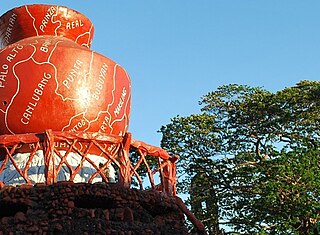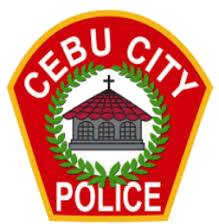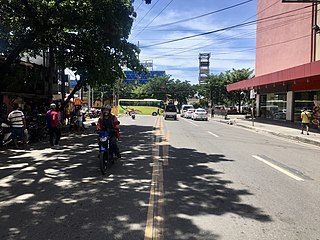
Cebu City, officially the City of Cebu, is a 1st class highly urbanized city in the Central Visayas region of the Philippines. According to the 2020 census, it has a population of 964,169 people, making it the sixth-most populated city in the nation and the most populous in the Visayas.

Calamba, officially the City of Calamba, is a 1st class component city in the province of Laguna, Philippines. According to the 2020 census, it has a population of 539,671 people.
The legislative districts of Cebu City are the representations of the highly urbanized city of Cebu in the various national legislatures of the Philippines. The city is currently represented in the lower house of the Congress of the Philippines through its first and second congressional districts.

Katipunan Avenue is a major avenue in Quezon City, Metro Manila, Philippines. It runs in a north–south direction from the University of the Philippines Diliman, intersecting with Tandang Sora Avenue at its northernmost point, down to the Manila Philippines Temple of The Church of Jesus Christ of Latter-day Saints, intersecting with White Plains Avenue at its southernmost point.

Osmeña Boulevard is a major arterial thoroughfare in Cebu City, Philippines. It is the city's "main street" which travels in a generally northwest–southeast orientation linking the old downtown district of San Roque near the harbor with the modern uptown Capitol Site district. Beginning at M.J. Cuenco Avenue in the east, the boulevard heads northwest towards Fuente Osmeña circle and ends at Escario Street. At its north end, the Cebu Provincial Capitol serves as a prominent terminating vista. It is the location of many of Cebu's notable institutions such as the Cebu Normal University, Abellana National School and Cebu Doctors' University Hospital; the Basilica of Santo Niño; one of the city's tallest buildings, Crown Regency Hotel; and shopping centers Robinsons Place Cebu and Gaisano Colon.

Colonel Bonny Serrano Avenue, formerly called and still referred to as Santolan Road, is a major east–west thoroughfare in the Eastern Manila District of Metro Manila, Philippines, running between San Juan and Quezon City. It forms the northern limit of San Juan and the southern limit of Quezon City's New Manila and Cubao districts and links the Philippine National Police headquarters in Camp Crame with the Armed Forces of the Philippines headquarters in Camp Aguinaldo. The avenue runs from the border of barangays Corazon de Jesus, St. Joseph, and Little Baguio in San Juan in the west to barangays Libis and Blue Ridge B near Quezon City's border with Marikina in the east. It was named after the decorated Korean War hero, Venancio "Bonny" Serrano.

The South Road Properties (SRP) is the name of a 300 hectare island-type reclamation area located off the coast of the southern district of Cebu City, near Barangays Mambaling, Inayawan, and Pasil. It spans from the shore of mainland Cebu to Kawit Point. It is connected from mainland Cebu by the Cebu South Coastal Road and the Mambaling Access Road.

Local elections were held in Cebu City on May 13, 2019 within the Philippine general election. Registered voters of the city elected candidates for the following elective local posts: mayor, vice mayor, district representative, and eight councilors at-large for each district. There are two legislative districts in the city.

Cebu City is politically subdivided into 80 barangays.

Edgardo Colina Labella was a Filipino politician and lawyer who served as the mayor of Cebu City from 2019 until his death in 2021. Prior to becoming mayor, he was the city's vice mayor from 2013 to 2019 and was a member of the Cebu City Council from 1998 to 2001 and again from 2004 to 2013.
Transportation within Cebu City is mainly land-based with most parts of the city accessible by road. There is no existing mass transit but there is an existing proposal for a Cebu Bus Rapid Transit System and Cebu Light Rail Transit System.

The Cebu City Police Office (CCPO) is a division of the Philippine National Police (PNP) which has jurisdiction over Cebu City and is under Police Regional Office VII. It is headquartered in Camp Sotero Cabahug.

Local elections will be held in Cebu City on May 9, 2022 within the Philippine general election. Registered voters of the city will be electing candidates for the following elective local posts: mayor, vice mayor, district representative, and eight councilors at-large for each district. There are two legislative districts in the city.
Tres de Abril Street is a national tertiary road in Cebu City, Cebu, Philippines. It commences at Spolarium Street in Barangay Pasil which connects Barangay Ermita through the Forbes Bridge, passes through the junctions of C. Padilla Street and N. Bacalso Avenue, and ends at the junction of F. Llamas Street in Barangay Punta Princesa. It was formerly considered as a national secondary road under Executive Order No. 113 issued by President Ramon Magsaysay on May 2, 1955.

F. Llamas Street is a national tertiary road in Cebu City, Cebu, Philippines. It commences at N. Bacalso Avenue in Barangay Basak San Nicolas, passes through the junction of Tres de Abril and E. Sabellano streets and ends at the junction of Katipunan Street in Barangay Tisa. It was formerly considered as a "national aid" city road under Executive Order No. 113 issued by President Ramon Magsaysay on May 2, 1955.
Dr. Jose P. Rizal Street, also known as Jose Rizal Street, is a short local road in Cebu City, Cebu, Philippines. It commences at P. Burgos Street as a one-way lane passing through the Legislative Building of the Cebu City Hall and ends at D. Jakosalem Street.
C. Padilla Street is a national tertiary road in Cebu City, Cebu, Philippines. It commences at Colon Street in Barangay Pahina Central, passes through several junctions in Barangays San Niolas Proper, Pahina San Nicolas, Sawang Calero and Duljo-Fatima and ends at the junction of F. Vestil Street and L. Gabuya Street in Barangay Mambaling.

National Route 8 (N8) is a 174-kilometer (108 mi), two-six lane north-south major primary national route that forms part of the Philippine Highway Network in the province of Cebu. There are four highways that make up the road: the Cebu North Road, General Maxilom Avenue, Osmeña Boulevard and Natalio Bacalso Avenue. It runs from Danao to Santander.
National Route 81 (N81) is a 34.6-kilometer (21.5 mi), east-west primary route which forms part of the Philippine Highway network in Cebu connecting the cities of Naga and Toledo. Two roads form the route, namely: Naga−Uling Road and Cebu−Toledo Wharf Road.

National Route 830 (N830) is a secondary route that forms part of the Philippine highway network from Santander to Carcar. There are four components of the route, namely Natalio Bacalso Avenue, Santander–Barili–Toledo Road, Carcar–Barili Road and Carcar–Barili–Mantapuyan Road.











